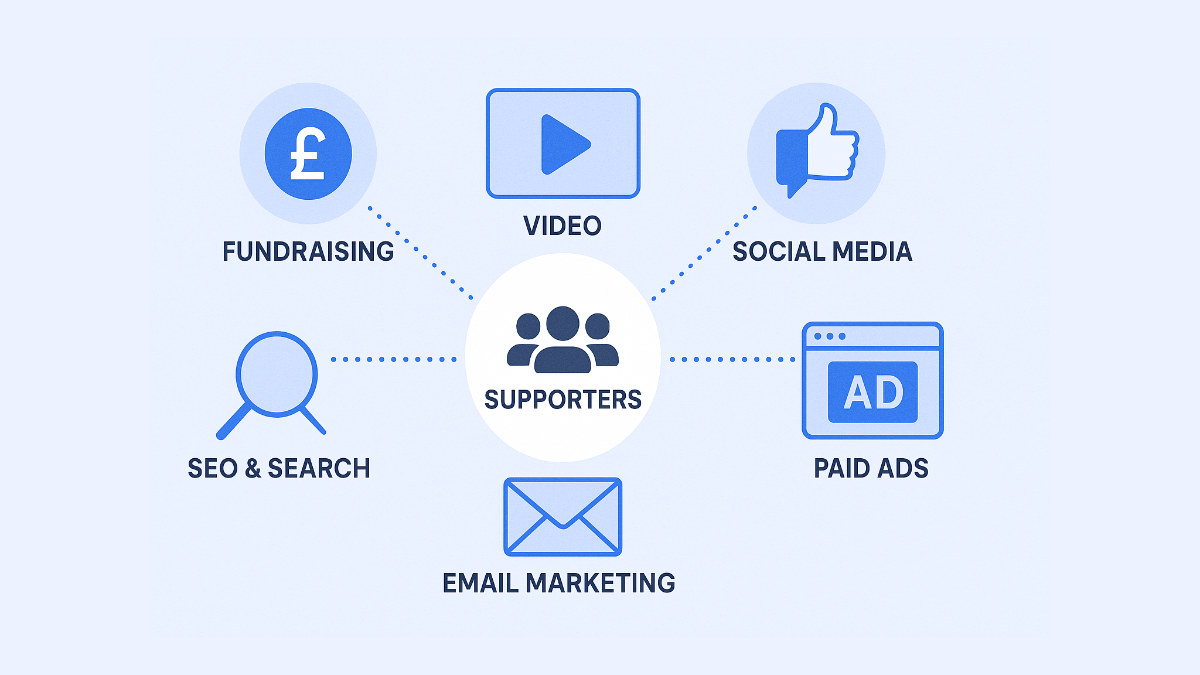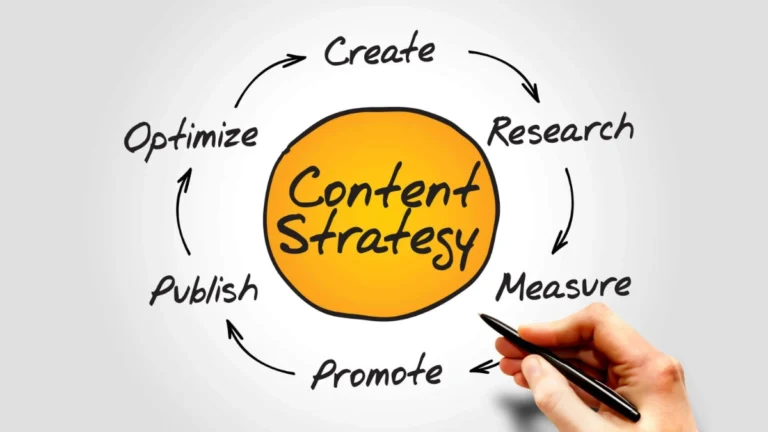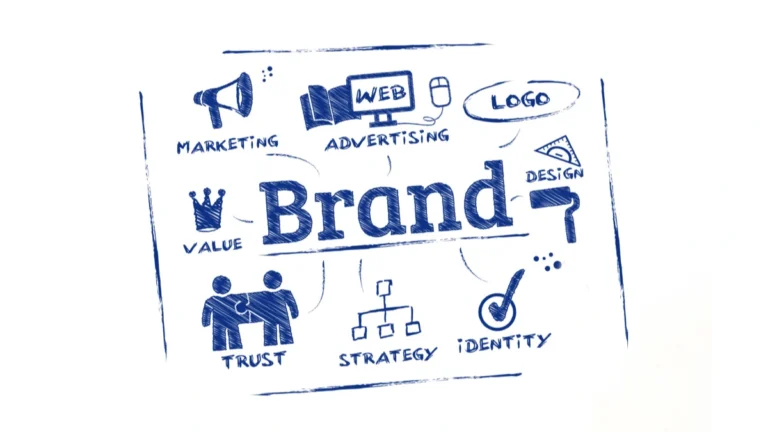What if your supporters felt seen, heard, and valued, no matter where they found you?
Whether it’s a quick scroll on Instagram, a campaign email, a volunteer event, or a Google search, people now expect the same charity to show up with the same voice, the same mission, and the same care across every channel.
That’s what omnichannel presence is all about.
It means your charity appears in all the right places, consistently, seamlessly, and with a single, defined message. From email marketing and social media to search, events, and even SMS, everything connects. Supporters don’t have to start over each time. Their journey continues, wherever they go next.
And in 2026 and beyond, this isn’t just a nice-to-have. It’s the new baseline.
People don’t think in terms of “channels.” They’re just living their lives on their phones, watching videos, reading blogs, checking emails. They might learn about you through a boosted post on Facebook, read your blog via Google, sign up to volunteer through your website, and donate through a reminder email weeks later.
If that journey feels bumpy or disconnected, if your tone shifts, your charity branding is off, or the next step isn’t clear, you lose momentum. You lose trust.
And with more people giving less often, every lost moment counts.
The data backs it up:
Charities using multiple, connected channels retain 89 out of 100 supporters, compared to only 33 out of 100 for single-channel efforts. That’s not a small gap; that’s the difference between growth and decline.
I write this article for UK charities who know they need to modernise their marketing, but don’t want to lose their human touch. Whether you’re a small team juggling 10 things or a mid-sized organisation ready to scale up, this is your practical guide to building and improving your omnichannel marketing strategy.
You’ll get:
- Clear steps to get started (or sharpen what you’ve already built)
- Tactics that don’t just sound good, they work
- A full checklist to launch or level-up your omnichannel presence
This isn’t theory. It’s what we use ourselves at Evolve Catalyst to help charities increase donor engagement, raise more through fundraising, and build long-term trust.
Let me break it down, starting with what “omnichannel” really means.
What Is Omnichannel Presence & Marketing for Charities?
Let me clear something up first: omnichannel isn’t the same as multichannel.
A lot of charities think they’re doing omnichannel marketing when they’re just active on multiple platforms. There’s a big difference, and it’s costing them results.
1. Multichannel and Omnichannel Compared
Multichannel means your charity is using more than one platform, say, social media, email and a website.
But they’re often working in silos. Your Facebook post says one thing. Your email says another. And your website? It hasn’t been updated in months.
Supporters see this. They feel the disconnect. And they’re less likely to trust your message.
Omnichannel, on the other hand, connects everything.
Your messaging, branding, and supporter data flow across all channels, online and offline, to create one joined-up experience.
That means:
- Someone who clicked a fundraising ad sees a follow-up email that makes sense.
- A supporter who signed up at an event gets personalised updates, not generic messages.
- Your charity looks, sounds, and feels the same everywhere, from Instagram stories to direct mail.
It’s not just about being everywhere. It’s about being consistent everywhere.
2. How Charities Can Deliver One Unified Supporter Experience
At the heart of omnichannel marketing is this idea: the supporter comes first.
People don’t want to repeat themselves, dig through clunky websites, or feel like a stranger each time they interact with you. They want:
- Personalised, relevant communication (based on how they’ve engaged before)
- A clear, consistent brand voice
- Easy ways to take action, whether that’s donating, volunteering, or spreading awareness
With the right systems (like a unified CRM, content calendar, and smart automation), charities can integrate digital and offline touchpoints like email, SEO, events, direct mail, Google Ad Grants, and SMS into one cohesive journey.
That’s omnichannel.
3. Why Omnichannel Matters for UK Charities Now
UK supporters are more connected and more selective than ever.
They support causes that feel trustworthy, communicate clearly, and make it easy to get involved. A scattered approach won’t cut it.
Here’s why omnichannel matters for charities right now:
- Trust is fragile. Inconsistent messages or mixed signals make donors hesitate.
- Giving is down, but average gifts are up, so every interaction matters more than ever.
- Digital habits are changing. People use multiple devices and platforms daily. If you’re not where they are, they’ll miss you.
- Search, social, and email all work better together. The more joined-up your channels, the better your SEO, engagement, and fundraising outcomes.
This shift isn’t just about marketing. It’s about how charities build relationships, raise money, grow awareness, and keep doing their vital work.
And the good news? You don’t need a massive team or a big budget to get started.
You just need a smart strategy, some solid systems, and a bit of consistency.
Top Reasons UK Charities Use Omnichannel Marketing
If you’re wondering whether it’s worth putting time into an omnichannel approach, here’s your answer: yes, absolutely.
It’s not just a marketing upgrade. It’s a way to make every part of your charity work better, from donor engagement to fundraising to service delivery.
1. Improving Supporter Retention Over Time
Supporters drop off when the experience feels disconnected, repetitive, or irrelevant.
Omnichannel marketing keeps the journey smooth, so people stay with you, donating, volunteering, and spreading the word.
- When charities use more than one channel in a coordinated way, they keep 89 out of 100 supporters.
- But if they rely on just one channel, they only keep 33 out of 100. That’s a huge difference in long-term impact.
2. Increasing Donations Through Better Trust
Consistent messaging builds confidence. When your social posts, donation pages, and emails all tell the same story (with the same tone and feel), people are more likely to give and give again.
Here’s the proof:
- When someone donates directly through a charity’s own website, they give 22% more than they do on third-party platforms.
- The average gift on a charity website is £41.37. On a generic platform, it’s only £32.25.
Why? Because people feel more connected and more confident in where their money is going.
3. Building a Stronger, Trusted Charity Brand
Mixed messages hurt your credibility. When your channels are out of sync, supporters question whether you’re organised or even legit.
Omnichannel fixes that.
With a clear, unified voice across platforms, whether it’s Instagram, your email newsletter, or a local event, your brand becomes recognisable, credible, and memorable.
People are 38% more likely to remember your charity’s name when they donate directly on your website. That kind of brand stickiness matters.
4. Doing More with Less Using Smart Marketing
Many charities worry that omnichannel marketing will take too much time or money. But it helps you do more with less.
- You stop duplicating effort across teams.
- You repurpose content (one blog becomes 3 social posts + an email).
- You automate supporter journeys using systems like Mailerlite or Salesforce CRM.
- You track what works (and cut what doesn’t) with built-in analytics tools.
Instead of constantly starting from scratch, your team works from a central strategy, and that saves serious time.
5. Real Results from the UK Charity Sector
This isn’t just theory; it’s already working for UK organisations.
a) Cancer Prevention Research Trust
They updated their website, focused on SEO, and used Google Ads to drive traffic.
The results? A 514% increase in organic search traffic, leading to more visibility, more donations, and more lives impacted.
b) Mobile Giving and Social Commerce
Younger donors, especially under 40, prefer online giving.
56 out of 100 people under 40 give online, compared to just 35 out of 100 over 40.
That’s why charities investing in mobile-first strategies (fast-loading websites, mobile donations, short-form social video) are already pulling ahead.
c) Multichannel Campaign Success
Campaigns that use three or more channels perform nearly 5x better than single-channel campaigns.
One UK charity layered social media, email, and Google Ad Grants to push their seasonal appeal. They beat their fundraising target within three weeks and spent less doing it.
Foundations of a Charity Omnichannel Strategy
So what makes an omnichannel strategy work? It’s not just about being on every platform; it’s about making all your efforts connect, align, and move in the same direction.
Here are the six core areas you need to focus on to get it right.
1. Audience & Intent Mapping
Who are you speaking to, and what do they care about?
Not every supporter is the same. A long-time donor and a first-time volunteer will need completely different messages, calls to action, and journeys.
Start by segmenting your audiences into clear groups:
- Donors (first-time, regular, major)
- Volunteers
- Beneficiaries
- Corporate partners
- Event attendees
- Lapsed supporters
Then, map out what each group is looking for. What are their motivations? Where do they spend time online? What problems are they trying to solve?
Use tools like Google Analytics, email marketing reports, charity CRM insights, and even short surveys to understand:
- How people find you (SEO, social, email, events)
- What actions they take on your site
- Where they drop off in the journey
Once you know this, you can speak to the right people, in the right way, at the right time.
2. Consistent Brand Voice & Messaging
If your charity sounds different on every channel, supporters won’t know who you are.
Your tone, language, values, and visual style need to feel familiar, whether someone’s seeing your Instagram reel, landing page, or event banner.
To stay consistent:
- Create a brand messaging guide with tone of voice, dos and don’ts, and visual rules
- Align your language with your mission, keep it human, warm, and values-led
- Develop core message pillars that stay the same across all platforms (e.g., your impact, your cause, your call to action)
Tip: Customise the message format to each platform, but keep the heart of the message the same.
3. Integrated Digital Platforms
Your digital tools need to talk to each other.
If someone donates via your website, their data should flow into your CRM. If they sign up for a newsletter, your email system should tag them for future updates. Disconnected systems break the supporter journey.
Here’s what you need in place:
- A fast, mobile-friendly website with clear CTAs and donation funnels
- An email marketing system to manage segmented journeys (Mailerlite, ActiveCampaign, etc.)
- Active, purpose-driven social media accounts (with links back to your website)
- A secure CRM system that holds supporter history and preferences
- Optionally, a mobile app or SMS system if you serve people on the move
And crucially, all your systems should pull into a single view of your supporter.
This enables better personalisation, better engagement, and fewer missed opportunities.
4. Content Strategy & SEO Foundations
If content is king, structure is the kingdom.
Content isn’t just what you say, it’s how you’re found, how you connect, and how people stay interested.
Without a plan, it turns into random posts and one-off appeals.
Here’s how to build it out.
Plan for every stage:
- Awareness (social posts, blog content, short videos)
- Engagement (email sequences, behind-the-scenes content)
- Conversion (fundraising pages, volunteer sign-up flows)
- Retention (impact stories, donor thank-you content)
Optimise for SEO:
- Research keywords your supporters search for (e.g., “how to support refugees in the UK,” “local food bank donations,” “charity events near me”)
- Use keywords in your headings, meta descriptions, and image alt text
- Use schema markup for events, donations, and blog articles
- Internally link to relevant content across your website (like we do at Evolve Catalyst)
Pro tip: Repurpose one story into a blog, a LinkedIn post, a Reel, and an email.
One story, four platforms, done right.
5. Channel Integration & Automation
No supporter wants a fragmented experience, like getting a generic email days after donating through social media.
Channel integration means all your platforms work together.
That way, when someone signs up, donates, or shares your campaign, the next message they receive makes sense.
Here’s what that could look like:
- Someone donates via a Facebook Ad → Gets a thank-you email with their name → Gets SMS updates about the next campaign → Sees retargeted ads with a custom message
- A volunteer signs up at an event → Gets a welcome email with relevant roles → Added to a quarterly volunteer update
Automation systems help you do this without the stress.
Try: Mailerlite, ActiveCampaign, Salesforce for Nonprofits, or your own CRM’s automation features.
Use automation for:
- Welcome journeys
- Donation follow-ups
- Event reminders
- Re-engagement campaigns
Just make sure the automation feels personal, not robotic.
6. Data Analytics & Measurement
If you’re not measuring what’s working, you’re guessing.
And most charities can’t afford to guess.
Omnichannel success comes down to data, not gut feel.
What to track:
- Website: traffic sources, bounce rate, goal completions (Google Analytics)
- Email: open rate, click-through rate, unsubscribe rate
- Social: reach, engagement, conversions (via Meta Insights or LinkedIn Analytics)
- SEO: keyword rankings, impressions, click-throughs (Google Search Console)
Set clear KPIs:
- Increase online donations by 20%
- Grow email list by 500 new contacts
- Improve landing page conversion rate from 1.8% to 3%
Also, use systems that show the full supporter journey across multiple channels. Attribution is messy, but you’ll start to see patterns if you’re consistent.
Each of these areas builds into the others.
When done right, they form a strategy that doesn’t just work on paper; it works in real life.
Your Charity’s Omnichannel Presence Guide
For charities navigating today’s digital space, knowing why omnichannel marketing matters is only part of the equation. The next step is knowing how to build and implement it.
Here’s a practical roadmap to help your organisation create a unified, strategic omnichannel presence without getting overwhelmed.
1. Set Defined Goals and KPIs
Before diving into tactics, take a step back and ask: what does success look like for your charity? Is it increased online donations? Volunteer sign-ups? Greater event attendance?
Define SMART goals (Specific, Measurable, Achievable, Relevant, Time-bound) aligned with your charity’s mission. Then, establish KPIs for each channel, open rates for email, conversion rates for donation pages, social media engagement, or SEO rankings. This will allow you to track what’s working and adjust the course effectively.
2. Conduct Audience Research
Your supporters are not a monolith. From older donors who prefer email to younger audiences engaging via Instagram or TikTok, each group has different expectations.
Use surveys, donor database insights, and web/social analytics to build detailed audience personas. Identify their motivations, preferred channels, digital behaviours, and accessibility needs. This ensures your content, campaigns, and tone resonate in the right way, on the right platform, at the right time.
3. Keyword Research & Local SEO
An omnichannel strategy is only as good as its visibility. Research high-impact keywords tied to your cause, services, and local area using tools like Google Keyword Planner, Ubersuggest, or SEMrush. Include:
- Cause-specific terms (e.g. “youth homelessness charity UK”)
- Local intent keywords (e.g. “food bank in Sheffield”)
- Action-based keywords (e.g. “how to donate clothes near me”)
Don’t forget your Google Business Profile and local citations; they’re vital for helping supporters find and trust your charity locally.
4. Develop a Content Calendar
Consistency is key to omnichannel success. A structured content calendar allows you to:
- Map campaigns across platforms (e.g. email + social + blog)
- Balance evergreen content with timely stories and appeals
- Plan seasonal or event-based messaging in advance (e.g. Ramadan, Christmas, Giving Tuesday)
This doesn’t require a large team, just discipline, coordination, and tools like Google Sheets, ClickUp, or Notion.
5. Optimise for Mobile and Accessibility
In 2025, over 70% of your digital traffic is likely to come from mobile. If your website, donation forms, or emails aren’t optimised for small screens and touch navigation, you’re losing potential impact.
Go further by ensuring accessibility for all users: add alt text, use readable fonts, maintain strong colour contrast, and follow WCAG guidelines. This not only broadens your reach, it also reflects your values.
6. Leverage Social Media and Paid Media
Build an organic presence across the platforms where your supporters already spend time Facebook, Instagram, LinkedIn, YouTube, or TikTok, based on your audience research.
Pair this with cost-effective paid strategies:
- Google Ad Grants: Free £7,500/month advertising budget for eligible charities.
- PPC campaigns: Targeted local fundraising or event campaigns.
- Paid social ads: Increase your best-performing content or appeals to drive awareness and donations.
Be strategic. Start small, test what works, and scale what performs.
7. Build Internal & External Links
Link-building isn’t just for SEO experts. It’s essential for improving search visibility and credibility.
- Internal links: Connect blog posts to your services, campaigns to your donation pages, FAQs to impact reports.
- External links: Collaborate with partners, local councils, faith centres, and media outlets to earn backlinks to your site.
Each high-quality link strengthens your domain authority and drives more organic traffic over time.
8. Monitor, Test and Adapt
No strategy is set in stone. Use systems like Google Analytics 4, Google Search Console, and platform-specific insights to regularly assess what’s working.
Run A/B tests on subject lines, call-to-actions, landing pages, and images. Schedule quarterly audits to clean up broken links, update keywords, and refine messaging based on supporter behaviour.
Remember: small, consistent improvements are better than one big campaign and months of silence.
Solving Key Challenges in Charity Omnichannel Strategies
Implementing an omnichannel marketing strategy can feel overwhelming, especially for small and medium-sized charities with limited budgets, capacity, or digital know-how. Below are some of the most common barriers UK charities face, along with practical tips to overcome them.
1. Manage Budget and Resource Constraints
Focus on high-impact, low-cost strategies like email marketing, organic SEO, and Google Ad Grants. Repurpose content across platforms and consider partnerships with volunteers for support.
2. Close Digital Skills Gaps and Build Confidence
Provide basic training for your team or access free resources from our resources for small UK charities or Charity Digital. Upskilling staff doesn’t have to mean big investments; consistency and bite-sized learning go a long way.
3. Fix Disconnected Systems and Improve Data Flow
Invest in effective charity CRM systems that integrate with your website and email systems. Start with one connected platform and build up from there. Clear data practices improve both efficiency and supporter trust.
4. Overcome Resistance to Change and Gain Team Buy-In
Involve staff early in planning and celebrate small wins to build momentum. Frame changes in terms of impact: more donations, better engagement, and reduced admin burden.
5. Stay on Track in a Fast-Moving Digital Space
Don’t aim for perfection. Focus on progress. Regularly review what’s working, adapt your approach, and keep learning. Even small tweaks can lead to major improvements over time.
6. Get Professional Help to Build Your Charity
Sometimes the best way to overcome multiple challenges, whether it’s limited resources, lack of digital expertise, or managing change, is by getting outside support. We help UK charities build their charity foundation the right way and grow with confidence. If you need strategic guidance, expert support, or a partner who understands the sector, we’re here to help.
What’s Next for Omnichannel Marketing in UK Charities
As the digital space evolves, so do the strategies charities must adopt to stay connected and effective. Below are key trends shaping the future of omnichannel marketing for UK charities.
1. AI and Automation in Personalisation
Artificial intelligence and automation are reshaping how charities engage supporters. From dynamic email content to intelligent donation prompts, these systems and tools help personalise supporter journeys at scale, making outreach feel more human, not less.
2. Rise of Mobile and Social Commerce
Supporters are increasingly interacting with charities on mobile and through social platforms. Features like Instagram donations, TikTok fundraisers, and mobile-friendly campaign pages are becoming essential tools for reaching younger, more digital-native audiences.
3. First-Party Data and Privacy Compliance
With GDPR and the decline of third-party cookies, first-party data is more important than ever. Charities need to collect and manage supporter data transparently and responsibly while using it to create customised, value-driven communications.
4. New and Emerging Digital Platforms
UK charities must keep an eye on emerging channels—from WhatsApp and Discord to voice search and the metaverse. Staying agile and curious about new platforms can help organisations stay relevant and engage audiences in new ways.
Your Omnichannel Strategy Launch Checklist
Use this practical checklist to help your charity take the first confident steps toward an effective omnichannel strategy. It covers essential actions, systems, tools and tips for each stage.
1. Set Clear Objectives
- Define your campaign or fundraising goals (e.g. raise £10,000, grow donor base by 20%).
- Align your goals with your mission and audience needs.
- Tool: SMART Goals Framework
2. Understand Your Supporters
- Segment your audience based on behaviour, interests, and demographics.
- Build supporter personas to customise your messaging.
- System: Google Analytics, Meta Audience Insights
3. Audit Your Existing Channels
- List all current digital and offline channels (email, website, social media, events).
- Evaluate what’s working and what needs improvement.
- Tool: Channel Audit Template (Excel or Notion)
4. Develop a Unified Content Plan
- Plan coordinated campaigns that run across multiple channels.
- Reuse and adapt content to fit each format (e.g. email → social post → video).
- System: ClickUp, Asana, or Notion for content planning
5. Choose Your Systems Wisely
- Select platforms that integrate well (e.g. CRM, email, SMS, donation systems).
- Prioritise systems that support automation and reporting.
- System: Mailerlite, Salesforce, Beacon CRM, GiveWP
6. Create and Optimise Campaign Assets
- Design mobile-friendly emails, donation pages, and create social posts.
- Ensure consistent branding and messaging throughout.
- Tool: Canva, Charitable, Unbounce
7. Launch with a Clear Journey
- Map out supporter journeys from first touch to action.
- Use triggers and follow-ups based on supporter behaviour.
- System: Email automation workflows (Mailerlite, ActiveCampaign)
8. Monitor and Measure Performance
- Track key metrics across all channels (e.g. open rates, conversions, donation volume).
- Review and refine regularly.
- System: Google Analytics, Meta Business Suite, CRM dashboards
9. Review, Learn and Improve
- Hold a post-campaign review to gather insights.
- Identify what to repeat, refine, or remove for future campaigns.
- Tool: Internal debrief template or meeting notes
10. Get Strategic Support (If Needed)
If you’re unsure where to begin or want help building your charity for long-term success, seek professional support.
We can help you Build Your Charity with strategy, structure, and sustainable growth.
My Final Thoughts
Omnichannel marketing is no longer optional; it’s essential for UK charities looking to build lasting supporter relationships and thrive in a competitive giving sector. Those who invest in a cohesive, personalised approach will be best positioned for sustainable impact and growth.
Start where you are. Begin with small, measurable steps and refine your strategy as you go. You don’t need to have it all figured out; progress beats perfection.
If you’d like customised support to build your charity’s foundation and launch an effective omnichannel strategy, book a consultation with our team; we’re here to help.
Stay Updated with the Latest Charity Insights
Sign up for our newsletter to receive valuable tips, updates, and exclusive offers to help your charity thrive.



